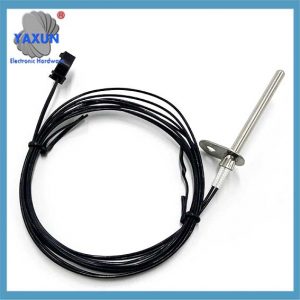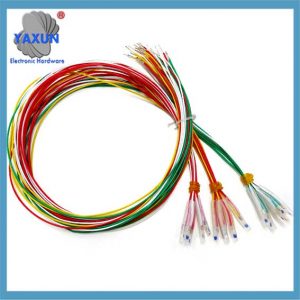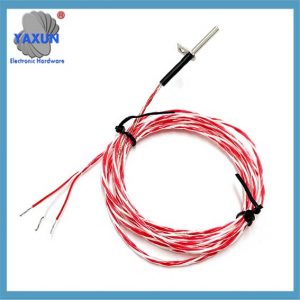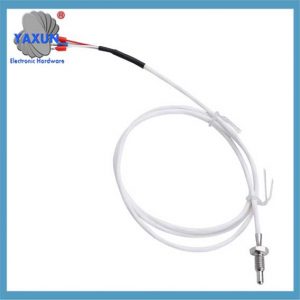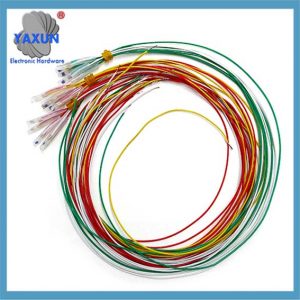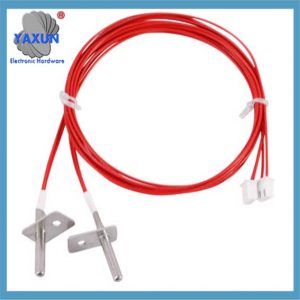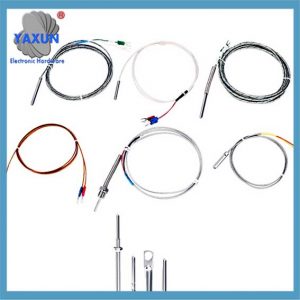EV 온도 센서 키트에는 다음이 포함됩니다.: 전기차 배터리팩 온도센서 외에, 모터 온도 센서; 인버터 온도 센서; 충전기 손잡이, 포트 및 고전압 커넥터 온도 센서; 열 관리 시스템 온도 센서; 객실 온도 센서; 후드 온도 센서.
고급 감지 기술과 혁신적인 임베디드 측정 솔루션의 선도적인 혁신자로서, Am페놀 Advanced Sensors는 신에너지 자동차 EV 온도 센서 분야의 세계적인 선두주자이기도 합니다.. 그들은 항상 새로운 센서 기술이 전기 자동차를 최적의 성능과 안전하게 운행하는 데 핵심적인 역할을 한다고 믿어 왔습니다..
신에너지차 시장이 확대되면서, EV 자동차 센서 시장도 성장할 것. 이유는 간단해요: 내연기관 자동차와 마찬가지로, 전기자동차는 성능과 안전성을 보장하기 위해 고성능, 정밀한 센서 기술이 필요합니다..
내연기관 자동차와 마찬가지로, 과열은 전기 자동차의 기능과 안전, 그리고 서비스 수명에 심각한 영향을 미칠 수 있습니다.. 자동차 온도 센서는 많은 구성 요소가 최적이 아닌 온도에 더 민감하거나 성능이 좋지 않기 때문에 EV에서 더 넓은 역할을 한다고 말할 수 있습니다..
1. 모터 온도 센서
EV 모터는 ICE 차량의 엔진과 다르지 않습니다. 서로 원활하게 작동하는 많은 부품이 있습니다.. 더 중요한 것은, 사용하면 뜨거워진다.
ICE 엔진처럼, EV 모터는 효율적으로 작동하려면 특정 온도 범위(90~95°C) 내에서 유지되어야 합니다.. EV에서 해당 범위를 초과하면 과열로 이어질 수 있습니다., 그 동안 엔진이 비효율적으로 작동하거나 안전 모드로 들어갈 수 있습니다..
모니터링을 위해 EV 온도 센서 설치:
모터 오일 온도
모터 권선 온도
모터 냉각수 온도
모터 온도 제어는 엄밀히 말하면 온도를 낮추는 것이 아닙니다.. 추운 기후에서는, 효율적으로 작동하려면 모터 온도를 약 15°C까지 올려야 합니다..
2. 인버터 온도 센서
모터에 전원을 공급하기 위해 DC를 AC로 변환하는 게이트웨이, 인버터는 전기차의 생명줄을 제어한다. 전류 변환의 부산물은 열입니다., 제어하지 않으면 온도 제한인 150°C를 훨씬 초과할 수 있습니다.. 장시간 과도한 열에 노출되었을 때, 내부 구성 요소에 오류가 발생하기 시작하고 장치가 제대로 작동하지 않습니다..
인버터 과열의 일반적인 영향은 다음과 같습니다.:
절연 열화
납땜 균열
금속 뒤틀림
3. 충전기 손잡이 및 포트 온도 센서
EV의 동력원으로서, EV 충전기의 핸들과 충전 포트도 과열될 수 있습니다.. 높은 온도는 여러 가지 문제를 나타냅니다.:
잘못된 연결
충전기 결함
고속 DC 충전 기술이 발전함에 따라, EV 충전 핸들과 포트의 온도를 모니터링하는 것이 점점 더 중요해질 것입니다.. 고속충전 기술로 충전시간은 단축됐지만 80% 청구하다 30 분, 오늘날의 소비자는 연료 탱크를 채우는 것과 같은 급유 경험을 찾고 있습니다..
고속 충전에는 많은 양의 전기 에너지를 변환해야 합니다., 많은 열을 발생시키는 것. 충전시간을 줄이기 위한 기술이 발전함에 따라, 온도 모니터링은 공정이 안전하고 효율적인지 확인하는 데 도움이 됩니다..
4. 열 관리 시스템 온도 센서
열 관리 시스템의 기본 기능은 전기 자동차의 기계 부품과 배터리를 조절하는 것입니다., 시스템 자체도 모니터링해야 합니다..
열 관리 시스템의 온도는 냉각되어야 하는 EV 구성 요소에 직접적인 영향을 미칩니다.. 체온이 정상 범위를 넘어 치솟았을 때, 도미노 효과가 일어날 수 있다, 이전에 나열된 것과 동일한 문제가 많이 발생합니다.. 냉각수 및 냉매 시스템의 주요 지점을 모니터링하는 온도 센서를 통해 적절한 시스템 온도를 유지하면서 성능을 최적화하고 전력 소비를 최소화하기 위해 시스템 컨트롤러에 중요한 정보를 제공합니다..
열 관리 시스템 내의 높은 온도는 무언가 잘못되었다는 확실한 신호입니다., 시스템 내부의 결함인지 – 누출과 같은 – 또는 냉각 중인 구성 요소 중 하나에 결함이 있습니다..
5. 객실 온도 센서
너무 덥거나 너무 추운 차량은 장시간 불편한 승차감을 유발할 수 있습니다.. 모터 외에도, 전기 자동차의 HVAC 시스템은 전기 자동차가 운행 중일 때 가장 눈에 띄는 작동 기능입니다..
전기차 기능의 초석은 효율성이다 – 또는 꼭 필요한 것보다 더 많은 전력을 사용하지 않는지 확인하십시오.. EV 센서는 자동차와 컴퓨터에 자동차 시스템이 얼마나 열심히 작동해야 하는지 정확하게 알려줍니다..
차량용 EV HVAC 시스템 온도 센서 포함, 운전자와 승객은 배터리를 너무 빨리 소모하거나 주행 거리를 줄이지 않고도 편안함을 유지할 수 있습니다..
6. 후드 온도 센서 아래
외부 온도 센서는 운전자와 승객에게 현재 기후를 알려주는 것이 아닙니다..
자동차 HVAC 온도 센서와 마찬가지로, 외부 장치가 차량에 다른 시스템이 있음을 알려줍니다., 열 관리 시스템과 같은, 주변 온도를 극복하기 위해 노력해야합니다. 외부 온도 센서는 일반적으로 자동차나 트럭의 후드 아래에 장착됩니다..
고속 충전 및 전기 자동차 센서: 필요한 페어링
운전자에게 자동차나 트럭의 가장 중요한 특징이 무엇인지 물어보세요., 그리고 대부분은 아마도 A 지점에서 B 지점으로 안전하게 이동할 수 있는 능력이 있다고 말할 것입니다.. 결국, 그게 자동차의 주요 기능이에요.
차량 소유자가 가장 원하지 않는 것은 차량이 준비되었을 때 차량이 아직 준비되지 않았음을 확인하는 것입니다.. 휘발유가 비어 있으면 중요한 고객 회의나 자녀의 축구 토너먼트에 참석할 수 없습니다.. 방전된 배터리도 마찬가지.
전기 자동차는 기존 내연기관 자동차와 다른 연료원을 사용하지만, 즉각적으로 차량이나 함대에 대한 소유자의 기대를 바꾸지 않았습니다., 주문형 교통.
배터리 기술의 발전에도 불구하고, 운전자가 충전소에서 멀리 떨어져 있는 최악의 시간에 전기 자동차의 배터리가 부족하다는 인식이 여전히 존재합니다.. 더 많은 것은 무엇입니까, 휘발유 자동차 소유자는 단 몇 분 만에 주유하는 데 익숙합니다.. 어떻게 전기차 충전이 지금처럼 빠르고 편리해질 수 있을까요??
오래 지속되는 모바일 전원과 결합, 고속 충전 전기 자동차 기술은 이러한 문제를 해결하고 전기 자동차가 화석 연료로 달리는 자동차 및 트럭과 보조를 맞추는 데 도움이 될 수 있습니다.
비록 그렇다 하더라도, 급속 충전 기술과 이에 수반되는 충전소 인프라는 잠재적인 EV 소비자가 재충전 시간 낭비에 대한 우려를 극복하는 데 충분하지 않습니다.. EV 운전으로의 원활한 전환을 원하는 사람들을 위해, 실질적인 결과가 중요하다. EV 센서는 주유소에서 주유하는 것만큼 빠르게 충전하는 데 필수적입니다..
고속 충전과 그 잠재적 영향 — EV 배터리 상태
EV 개발 초기에 누락된 퍼즐 조각으로, 새로운 고속 충전 기술은 부분적으로 운송의 지속적인 전기화를 촉진했습니다.. 고속 충전 시스템은 EV로의 전환을 더욱 실용적으로 만들어줍니다., 적절한 모니터링 없이는 사용할 수 없습니다..
왜? 고속 충전의 주요 부산물은 열입니다., 특히 전류를 AC에서 DC로 변환할 때. 열은 EV 배터리 팩의 최대 적이다.
EV 센서는 고속 충전을 모니터링해야 합니다. 3 장소
센서 기술을 통해 안전하고 효율적으로 고속 EV 충전을 시작하고 중지할 수 있습니다.. 고속 충전을 위해서는 빠르게 반응하는 센서(주로 차량 온도 센서)가 필요합니다..
이상적인 온도를 유지하기 위해 시스템을 트리거하는 실시간 모니터링이 없습니다., EV 부품의 열 손상 위험이 급격히 증가합니다..
전기차에 급속 충전을 위해 온도 센서를 장착해야 하는 곳은 세 군데다.:
연결점
열 관리 시스템
배터리 팩 내부
1. 연결점
연결 지점에는 온도 센서가 있어야 하는 두 곳이 있습니다.: 충전포트와 충전손잡이.
빠른 충전을 위해, 많은 전자가 EV 서비스 장치에서 차량 배터리로 빠르게 전달되어야 합니다.. 이 높은 전류는 열을 발생시킵니다.. 충전 포트 내부 온도가 높으면 충전 핸들과 EV 접점 사이의 연결 상태가 좋지 않음을 나타낼 수 있습니다.. 효율성 관점에서, 연결 상태가 좋지 않으면 차량이 필요한 만큼 빠르게 충전되지 않는다는 의미입니다.. 게다가, EV 고속 충전기 커넥터의 고온은 충전기에 전력 수요로 인해 과부하가 발생했음을 나타낼 수도 있습니다., 또는 오작동이 시작되고 있습니다..
2. 열 관리 시스템
EV의 열 관리 시스템 내 과열은 시스템이 의도한 대로 작동하지 않고 부품이 과열되고 있다는 즉각적인 신호입니다., ~와 같은:
열교환기
냉각판
냉각수
냉각제
절연유
과도한 온도는 냉각해야 하는 구성 요소의 과열로 인해 EV 냉각 시스템이 압도당하고 있음을 나타낼 수도 있습니다..
3. 배터리
리튬 이온 배터리는 다음 시간 동안 잘 충전됩니다. 45 그리고 60C, 하지만 해당 온도보다 약간 높은 온도에서 충전하면 손상될 수 있습니다.. 배터리 팩 내부 온도가 해당 범위를 초과하는 경우, 차량이 안전 모드로 진입하여 정지될 수 있습니다., 또는 더 나쁘다, 열폭주 과정을 시작하다.
배터리 과열은 차량의 충전 또는 열 관리 시스템에 문제가 있음을 나타내는 마지막 지표 중 하나입니다., 아니면 배터리 자체에 문제가 있는건가요?.
배터리의 장기적인 기능과 안전성을 유지하려면 즉각적인 냉각이 필요합니다..
EV용 고속 충전의 미래
전기차 열관리를 위한 급속충전 기술 개발은 아직 끝나지 않았다.
기존 고속충전 기술 활용, 소요되는 시간 30 EV 배터리를 재충전하는 데 몇 분 80 퍼센트. 하지만, 엔지니어들은 여전히 내연기관 자동차의 빈 탱크를 채우는 것만큼 빠르게 EV를 완전히 충전할 수 있도록 노력하고 있습니다. 10 분.
초고속 EV 충전에 대한 수요는 전적으로 편의성에 대한 욕구에서 비롯된 것은 아닙니다.. 육상 운송 회사 및 대형 차량 보유 회사 (세미트레일러 및 버스) 몇 분 안에 차량을 이동할 수 있는 초고속 충전을 거의 보편적으로 요구했습니다..
간단히 말해서, 대형 차량의 배터리 팩은 전기 자동차에 사용되는 배터리 팩보다 몇 배 더 큽니다.. 충전하는 데 시간이 더 오래 걸립니다.. 하지만 충전에 소요되는 시간은 생산성과 수익 손실을 의미합니다..
EV 전체의 열을 모니터링하는 빠른 응답 센서는 다음을 수행하는 데 필수적입니다.:
차량을 더 빠르게 서비스에 복귀시키세요;
배터리 성능 저하 또는 손상 방지;
EV 센서 및 고속 충전 시스템: 꼭 필요한 페어링.
전기화는 교통 역사상 가장 큰 변화 중 하나입니다., 차량 소유자와 운전자는 여전히 일정 수준의 기능을 기대합니다.. 고속 충전 기술은 주요 문제를 정면으로 해결하기 때문에 이러한 변화를 가능하게 합니다.. EV 센서는 EV 충전을 탱크에 물을 채우는 것처럼 조용하게 만드는 숨은 영웅입니다..
EV 열 관리 | 전기화 혁명을 주도하다
차량 뒤에 있는 실제 힘은 우리가 A 지점에서 B 지점으로 이동하는 방식을 변화시키고 있습니다.. 이를 수행하려면, 차량을 효율적이고 안전하게 작동시키는 데 필요한 센서 기술은 견고해야 합니다., 믿을 수 있는, 그리고 반응이 좋다.
이러한 속성은 EV 열 관리와 관련하여 가장 중요합니다.. 전기 자동차 사용의 천연 부산물, 전기 자동차의 완화되지 않은 과열, 트럭, 또는 모든 유형의 차량이 전기화 혁명을 탈선시킬 가능성이 있습니다.. 소비자와 소비자 보호 기관은 안전 실패나 오해에 관해 아주 좋은 오랜 기억을 가지고 있습니다..
적절한 센서 기술을 EV 디자인에 통합함으로써, EV 열 관리는 지속적입니다.. 더 중요한 것은, 전기 자동차의 성능은 천천히 노화되는 가솔린 구동 이전 자동차와 사실상 구별할 수 없습니다..
 English
English العربية
العربية Български
Български 粤语
粤语 中文(简体)
中文(简体) 中文(漢字)
中文(漢字) Nederlands
Nederlands Suomi
Suomi Français
Français Deutsch
Deutsch Ελληνικά
Ελληνικά Magyar
Magyar Italiano
Italiano 日本語
日本語 한국어
한국어 Polski
Polski Português
Português Română
Română Русский
Русский Slovenščina
Slovenščina Español
Español Svenska
Svenska ภาษาไทย
ภาษาไทย Türkçe
Türkçe Tiếng Việt
Tiếng Việt

